语言学概论考研真题2009A
语言学概论习题与答案2009年01月
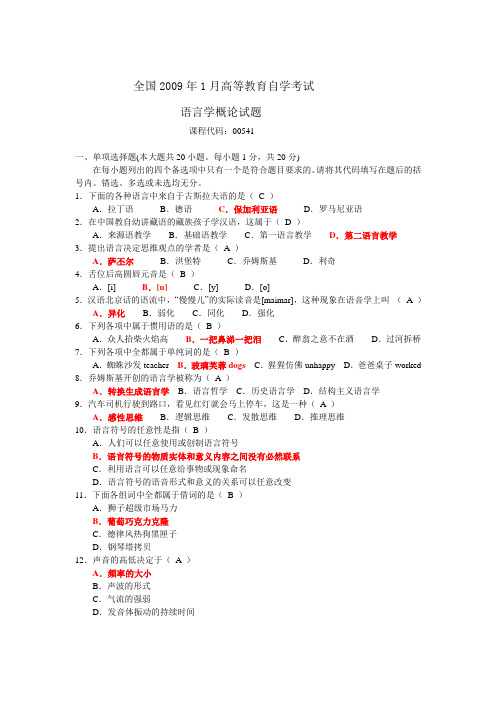
全国2009年1月高等教育自学考试语言学概论试题课程代码:00541一、单项选择题(本大题共20小题。
每小题1分,共20分)在每小题列出的四个备选项中只有一个是符合题目要求的。
请将其代码填写在题后的括号内。
错选、多选或未选均无分。
1.下面的各种语言中来自于古斯拉夫语的是(C )A.拉丁语B.德语C.保加利亚语D.罗马尼亚语2.在中国教自幼讲藏语的藏族孩子学汉语,这属于(D )A.来源语教学B.基础语教学C.第一语言教学D.第二语言教学3.提出语言决定思维观点的学者是(A )A.萨丕尔B.洪堡特C.乔姆斯基D.利奇4.舌位后高圆唇元音是(B )A.[i] B.[u] C.[y] D.[o]5.汉语北京话的语流中,“慢慢儿”的实际读音是[maimar],这种现象在语音学上叫(A )A.异化B.弱化C.同化D.强化6.下列各项中属于惯用语的是(B )A.众人拾柴火焰高B.一把鼻涕一把泪C.醉翁之意不在酒D.过河拆桥7.下列各项中全都属于单纯词的是(B )A.蜘蛛沙发teacher B.玻璃芙蓉dogs C.猩猩仿佛unhappy D.爸爸桌子worked 8.乔姆斯基开创的语言学被称为(A )A.转换生成语言学B.语言哲学C.历史语言学D.结构主义语言学9.汽车司机行驶到路口,看见红灯就会马上停车,这是一种(A )A.感性思维B.逻辑思维C.发散思维D.推理思维10.语言符号的任意性是指(B )A.人们可以任意使用或创制语言符号B.语言符号的物质实体和意义内容之间没有必然联系C.利用语言可以任意给事物或现象命名D.语言符号的语音形式和意义的关系可以任意改变11.下面各组词中全都属于借词的是(B )A.狮子超级市场马力B.葡萄巧克力克隆C.德律风热狗黑匣子D.钢琴塔拷贝12.声音的高低决定于(A )A.频率的大小B.声波的形式C.气流的强弱D.发音体振动的持续时间13.儿童开始正确使用虚词和掌握形态变化时,就进入儿童语言获得过程中的(D )A.单词阶段B.双词阶段C.简单句阶段D.复杂句阶段14.人脑中掌管人体运动平衡能力的部位是(C )A.大脑B.脑干C.小脑D.脑桥15.语言最小的音义结合的语言单位是( B )A.音素B.语素C.义素D.位素16.下面各项中属于向心词组的是(A )A.花衣裳B.彩色的C.心里美D.花红了17.辅音文字的创造者是(C )A.玛雅人B.苏美尔人C.腓尼基人D.印第安人18.日文的假名是典型的(B )A.音位文字B.音节文字C.辅音文字D.词语文字19.患者能够说出一些词语,发音也很准确,但词语之间在意义上没有联系,构成不了完整的句子,而且也听不懂别人说的话,这种语言障碍叫做( C )A.皮亚杰失语症B.布洛卡失语症C.维尔尼克失语症D.斯金纳失语症20.把语言学的理论和具体成果用来为社会实际生活中的某个领域服务的语言学分支学科是(B )A.普通语言学B.应用语言学C.具体语言学D.描写语言学二、多项选择题(本大题共5小题,每小题2分,共10分)在每小题列出的五个备选项中至少有两个是符合题目要求的,请将其代码填写在题后的括号内。
《语言学概论》考试卷(A)(5篇模版)

《语言学概论》考试卷(A)(5篇模版)第一篇:《语言学概论》考试卷(A)一、单项选择题1、普遍语法的提出者是()A、洪堡特B、索绪尔C、乔姆斯基D、布洛卡2、语言的发展演变是不平衡的,变化最慢的是()A、语音B、词汇C、语法D、修辞3、下列关于“组合规则、聚合规则”的表述不正确的是()A、组合规则关注的是线性搭配问题,聚合规则研究同功能的替换问题B、组合规则是现实的,聚合规则是潜在的C、组合规则和聚合规则是结构主义语法学提出的D、组合规则、聚合规则各自独立4、英语的man—→men采用的语法手段是()A、屈折变化B、变换重音的位置C、变化中缀D、异根5、下面关于语义模糊性的表述不正确的一项是()A、词义反映的对象只有一个大致的范围 B、词义的中心是明确的 C、有不少词的词义是精确的D、模糊性影响了人们的交际,所以要多造一些专有名词6、人类几种古老文字的原始字形,都是()A、象形的B、会意的C、表音的D、假借的7、洋泾浜语和克里奥耳语属于语言的()A、语言的借用和吸收B、语言的转用C、语言的D、双语现象8、关于语言能力,下列表述正确的一项是()A、语言能力指语言表达能力B、语言能力指利用语言进行思考的能力C、语言能力指不同年龄段获得语言的能力D、语言能力指人类的大脑为人类提供了掌握语言的先天基础9、“戏子”、“厨子”等词语在现代汉语中改用“演员”、“炊事员”,这种变化是()。
A、词义的消亡 B.词语的替换 C.词义的演变 D、词语的消亡10、把现代汉语第三人称代词写成“他”、“她”()A、表示性范畴B、表示格范畴C、表示人称范畴D、什么语法范畴都不表示二、多项选择题1、基本词汇的特点是()A、数量最多 B、使用范围广 C、理据性强D、产生历史长E、构词能力强2、一个元音的发音特征取决于()A、起主要作用的部位B、声带是否振动C、唇形的圆展D、舌位的前后E、舌位的高低3、根据字符跟语言单位的语义还是语音相联系的标准可以将文字分为()A、音节文字B、音位文字C、表意文字D、意音文字E、表音文字4、下面提到的研究内容,属于广义的应用语言学范畴的是()A、外语教学的规律B、母语教学规律C、社交称谓语的演变规律D、语言规范化问题E、语言信息处理5、来自原始印欧语的亲属语言有()A、拉丁语B、日耳曼语C、古斯拉夫语D、苗语E、阿尔泰语三、名词解释(本大题共4小题,每小题4分,共16分)每一名词解释都须举例。
2009年北京语言大学817语言学概论考研专业课真题及答案(写写帮整理)
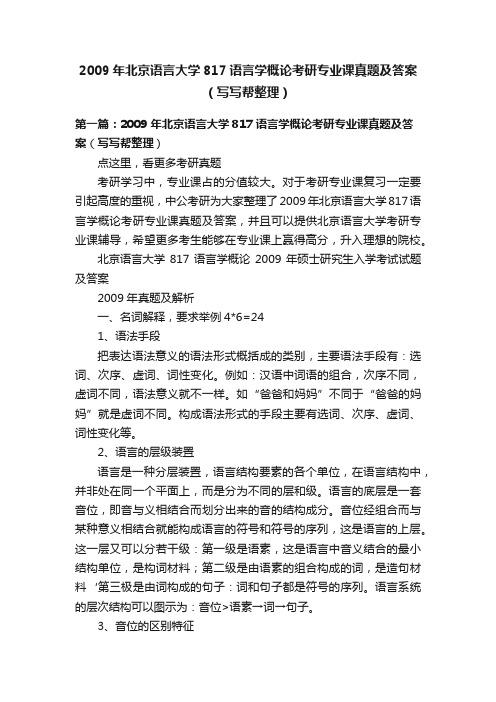
2009年北京语言大学817语言学概论考研专业课真题及答案(写写帮整理)第一篇:2009年北京语言大学817语言学概论考研专业课真题及答案(写写帮整理)点这里,看更多考研真题考研学习中,专业课占的分值较大。
对于考研专业课复习一定要引起高度的重视,中公考研为大家整理了2009年北京语言大学817语言学概论考研专业课真题及答案,并且可以提供北京语言大学考研专业课辅导,希望更多考生能够在专业课上赢得高分,升入理想的院校。
北京语言大学817语言学概论2009年硕士研究生入学考试试题及答案2009年真题及解析一、名词解释,要求举例4*6=241、语法手段把表达语法意义的语法形式概括成的类别,主要语法手段有:选词、次序、虚词、词性变化。
例如:汉语中词语的组合,次序不同,虚词不同,语法意义就不一样。
如“爸爸和妈妈”不同于“爸爸的妈妈”就是虚词不同。
构成语法形式的手段主要有选词、次序、虚词、词性变化等。
2、语言的层级装置语言是一种分层装置,语言结构要素的各个单位,在语言结构中,并非处在同一个平面上,而是分为不同的层和级。
语言的底层是一套音位,即音与义相结合而划分出来的音的结构成分。
音位经组合而与某种意义相结合就能构成语言的符号和符号的序列,这是语言的上层。
这一层又可以分若干级:第一级是语素,这是语言中音义结合的最小结构单位,是构词材料;第二级是由语素的组合构成的词,是造句材料‘第三极是由词构成的句子:词和句子都是符号的序列。
语言系统的层次结构可以图示为:音位>语素→词→句子。
3、音位的区别特征有区别音位的作用的发音特征。
具体因袭中能将一个音位同别的音位区别开来的语音特中公考研,让考研变得简单!更多资料,请关注中公考研网点这里,看更多考研真题征。
一个音位实际上是若干个区别特征的总和。
音位的区别特征不仅可以使不同的音位相互区别,形成对立,而且还可以使不同的音位通过相同的区别特征联系在一起,聚合成群。
4、会话含意是语用学的重要概念,分为一般会话含义和特殊会话含义。
2009年福建华侨大学汉语言文字学考研真题A卷

2009年福建华侨大学汉语言文字学考研真题A卷
一、按照拼写规则用汉语拼音给下列材料注音。
(计16分)
伟大的天文学家哥白尼说∶"人的天职在勇于探索真理。
"我国人民历来是勇于探索,勇于创新,勇于革命的。
我们一定要打破常规,披荆斩棘,开拓我国科学发展的道路。
二、用国际音标给下列诗句注音。
(要求用五度标记法标明实际调值,计14分)
不识庐山真面目,只缘身在此山中。
三、按要求分析下列音节结构。
(计10分)
四、分析下列词语的构成方式。
(计10分)
1.陈兵
2.陈列
3.埋怨
4.异化
5.吃准
6.藐视
7.召集
8.危如累卵
9.陈词滥调
10.画蛇添足
五、请举例说明象形字和指事字的区别。
(计10分)
六、在下列句子中任选一个配成一副对联。
(计10分)
翠柳迎春千里绿
春风春雨引万般春色
七、用层次分析法分析下列短语。
(计20分)
村子里回来了一批转业军人病魔逼他不得不放下手中的笔查完病房回到家里躺下就睡两个中医学院的学生来了
八、《汉语拼音方案》中的e包含了几个音位、几个变体?请在舌面元音舌位唇形图上用国际音标标明,并说说为什么《汉语拼音方案》可以只用一个符号表示?(计10分)
九、论述题∶(计50分,其中第1、2两题每题15分,第3题20分)
1.请举例说明汉语与英语在词的功能(即词类与句法成分的关系)方面的主要异同。
2.请举例说明排比和层递如何区别?
3.请分析网络语出现的原因,并谈谈你的看法。
温州大学语言学概论2009真题

2009年硕士研究生招生入学考试试题
科目代码及名称: 语言学概论(813)(A)卷适用专业:汉语言文字学、语言学及应用语言学(请考生在答题纸上答题,在此试题纸上答题无效)
一、名词解释(每题2分,共12分)
1)小学2)国际音标3)组合关系4)音质音位5)语法范畴6)洋泾浜语
二、判断题,下列句子表述正确的打“√”,错误的打“×”。
(每题1分,共12分)
1)历史比较语言学使语言学成为一门独立的科学。
2)音位是最小的意义单位。
3)“鲁迅是运用语言的楷模,他的语言很值得我们学习。
”句中的两个“语言”完全相同。
4)语素、词和句子之间没有必然的大小关系。
5)[p t k p’t’ k’]在汉语中属于3个音位,在英语中属于6个音位。
6)词缀是依附在词干上的语素。
7)组合规则是潜在的,聚合规则是现实的。
8)语法是一种有解释力的规则,即语法规则环环相扣,一条规则受另一条规则的制约,或另一条规则补充这一条规则,这是因为语法规则具有系统性。
9)近义词“恐吓”和“吓唬”意义上的差别主要在于语体色彩。
10)汉字是高级的书面语言。
11)亲属语言是从同一种语言分化出来的几种独立的语言,彼此有同源关系,汉语和藏语是亲属语言。
12)双语现象是某一言语社团使用两种或多种语言的社会现象。
三、填空(每空1分,共25分)
1)瑞士的著作标志着结构主义语言学的诞生。
2)交际是由、发码、、和五部分组成的。
2009综合卷
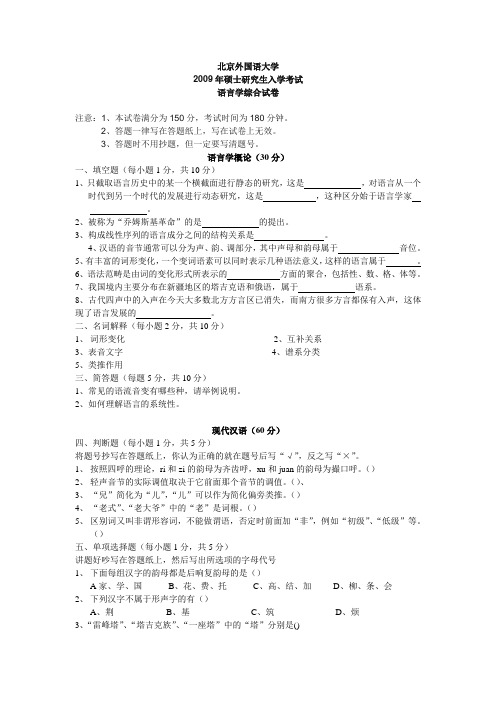
北京外国语大学2009年硕士研究生入学考试语言学综合试卷注意:1、本试卷满分为150分,考试时间为180分钟。
2、答题一律写在答题纸上,写在试卷上无效。
3、答题时不用抄题,但一定要写清题号。
语言学概论(30分)一、填空题(每小题1分,共10分)1、只截取语言历史中的某一个横截面进行静态的研究,这是,对语言从一个时代到另一个时代的发展进行动态研究,这是,这种区分始于语言学家。
2、被称为“乔姆斯基革命”的是的提出。
3、构成线性序列的语言成分之间的结构关系是。
4、汉语的音节通常可以分为声、韵、调部分,其中声母和韵母属于音位。
5、有丰富的词形变化,一个变词语素可以同时表示几种语法意义,这样的语言属于。
6、语法范畴是由词的变化形式所表示的方面的聚合,包括性、数、格、体等。
7、我国境内主要分布在新疆地区的塔吉克语和俄语,属于语系。
8、古代四声中的入声在今天大多数北方方言区已消失,而南方很多方言都保有入声,这体现了语言发展的。
二、名词解释(每小题2分,共10分)1、词形变化2、互补关系3、表音文字4、谱系分类5、类推作用三、简答题(每题5分,共10分)1、常见的语流音变有哪些种,请举例说明。
2、如何理解语言的系统性。
现代汉语(60分)四、判断题(每小题1分,共5分)将题号抄写在答题纸上,你认为正确的就在题号后写“√”,反之写“×”。
1、按照四呼的理论,ri和zi的韵母为齐齿呼,xu和juan的韵母为撮口呼。
()2、轻声音节的实际调值取决于它前面那个音节的调值。
()、3、“兒”简化为“儿”,“儿”可以作为简化偏旁类推。
()4、“老式”、“老大爷”中的“老”是词根。
()5、区别词又叫非谓形容词,不能做谓语,否定时前面加“非”,例如“初级”、“低级”等。
()五、单项选择题(每小题1分,共5分)讲题好吵写在答题纸上,然后写出所选项的字母代号1、下面每组汉字的韵母都是后响复韵母的是()A家、学、国B、花、费、托C、高、结、加D、柳、条、会2、下列汉字不属于形声字的有()A、荆B、基C、筑D、烦3、“雷峰塔”、“塔吉克族”、“一座塔”中的“塔”分别是()A、词、语素、字B、语素、字、词C、词、字、语素D、语素、词字4、按“从大到小”的分析方法,短语“著名剧作家曹禺创作的剧本《雷雨》”第一层结构关系应该是()A、述宾关系B、偏正关系C、主谓关系D、同位关系5、下面属于倒装句的是()A、帅呆了,你!B、你也有三十好几了吧,小李?C、棒球我打过。
2009年中山大学外国语学院840语言学概论考研真题及答案【圣才出品】
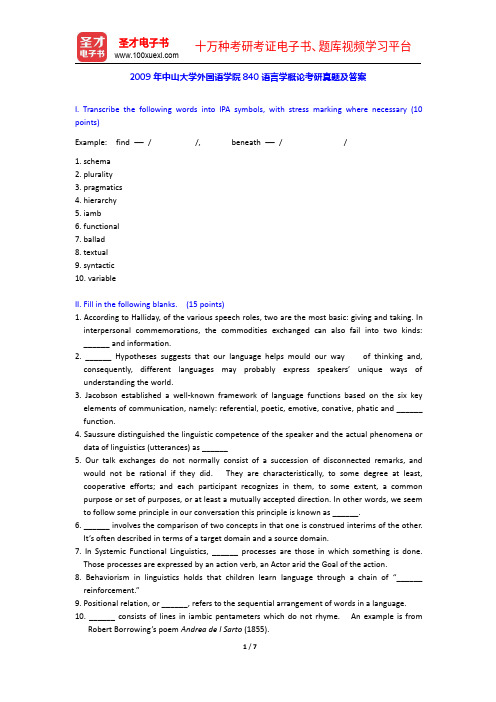
2009年中山大学外国语学院840语言学概论考研真题及答案I.Transcribe the following words into IPA symbols,with stress marking where necessary(10 points)Example:find—//,beneath—//1.schema2.plurality3.pragmatics4.hierarchy5.iamb6.functional7.ballad8.textual9.syntactic10.variableII.Fill in the following blanks.(15points)1.According to Halliday,of the various speech roles,two are the most basic:giving and taking.In interpersonal commemorations,the commodities exchanged can also fail into two kinds: ______and information.2.______Hypotheses suggests that our language helps mould our way of thinking and, consequently,different languages may probably express speakers’unique ways of understanding the world.3.Jacobson established a well-known framework of language functions based on the six key elements of communication,namely:referential,poetic,emotive,conative,phatic and______ function.4.Saussure distinguished the linguistic competence of the speaker and the actual phenomena or data of linguistics(utterances)as______5.Our talk exchanges do not normally consist of a succession of disconnected remarks,and would not be rational if they did.They are characteristically,to some degree at least, cooperative efforts;and each participant recognizes in them,to some extent,a common purpose or set of purposes,or at least a mutually accepted direction.In other words,we seem to follow some principle in our conversation this principle is known as______.6.______involves the comparison of two concepts in that one is construed interims of the other. It’s often described in terms of a target domain and a source domain.7.In Systemic Functional Linguistics,______processes are those in which something is done. Those processes are expressed by an action verb,an Actor arid the Goal of the action.8.Behaviorism in linguistics holds that children learn language through a chain of“______ reinforcement.”9.Positional relation,or______,refers to the sequential arrangement of words in a language.10.______consists of lines in iambic pentameters which do not rhyme.An example is fromRobert Borrowing’s poem Andrea de I Sarto(1855).exposed to should be just far enough beyond their current competence so that they can understand most of it but still be challenged to make progress.12.A general______is a collection of material which is broadly homogeneous,but which isgathered from a variety of sources so that the individuality of a source is obscured,unless there searcher isolates a particular text.13.The Prague School is best known and remembered for its contribution to phonology and thedistinction between______and phonology.14.______is the smallest a unit of language in terms of the relationship between expression andcontent,a unit that cannot be divided into further smaller units without destroying or drastically altering the meaning,whether it is lexical or grammatical.15.Chomsky believes that language is somewhat inmate,and that children are born with what hecalls a______which is a unique kind of knowledge that fits them for language learning.III.Define the following terms.(50points)1.ideational functionmunicative syllabusponential analysis4.cognition5.illocutionary act6.arbitrariness7.concordance8.hyponymy9.assimilation10.Quality MaximIV.Explain the following statements with examples.(30points)1.Words are the most stable of all linguistic units,in respect of their iceman structure,that is,theconstituent parts of a complex word have little potential for rearrangement,compared with the relative positional mobility of the constituents of sentences in the hierarchy.2.Endocentric construction is one whose distribution is functionally equivalent to that of one ormore of its constituents.3.Concord may be defined as the requirement that the forms of two or more words of specificword classes that stand in specific syntactic relationship with one another shall also be characterized by the same paradigmatically marked category(or categories).V.Answer the following questions with examples where necessary.(45points)1.What is folk etymology?2.What is the difference between regional dialect and social dialect?3.Why is the syllabus very important in a language teaching programmer?参考答案I.Transcribe the following words into IPA symbols,with stress marking where necessary(10 points)1.schema—/'ski:mə/2.plurality—/pluə'ræliti/3.pragmatics—/præɡ'mætiks/4.hierarchy—/'haiərɑ:ki/5.iamb—/'aiæmb/6.functional—/'fʌŋkʃənəl/7.ballad—/'bæləd/8.textual—/'tekstʃuəl/9.syntactic—/sɪn'tæktɪk]/10.variable—/'vɛəriəbl/II.Fill in the following blanks.(15points)1.goods-&-services2.Sapir-Whorf3.metalingualngue and parole5.the Cooperative Principle6.metaphor7.material8.stimulus-response9.word order10.Blank verse11.i+112.corpora13.phonetics14.Morphemenguage acquisition deviceIII.Define the following terms.(50points)according to Halliday,is to convey new information,to communicate a content that is unknown to the hearer.Present in all language uses,the ideational function is a meaning potential.The ideational function mainly consists of“transitivity”and“voice”.This function not only specifies the available options in meaning but also determines the nature of their structural realizations.municative syllabus:A communicative syllabus aims at the learner’s communicative competence.Based on a notional-functional syllabus,it teaches the language needed to express and understand different kinds of functions,and emphasizes the process of communication.ponential analysis:It refers to a semantic approach which defines the meaning of a lexical element in terms of semantic components,or semantic features.For example,the meaning of the word boy may be analyzed into three components:HUMAN,YOUNG and MALE.4.cognition:The term“cognition”is used to refer to the mental processes of an individual,with particular relation to a view that argues that the mind has internal mental states(such as beliefs,desires,and intentions)and can be understood in terms of information processing, especially when a lot of abstraction or concretization is involved,or processes such as involving knowledge,expertise or learning for example are at work.Another definition of“cognition”is the mental process or faculty of knowing,including aspects such as awareness,perception, reasoning,and judgment.5.illocutionary act:According to Austin,a speaker might be performing three acts simultaneously when speaking.An illocutionary act is the act of expressing the speaker’s intention;it is the act performed in saying something.Therefore,when somebody says“Morning”,we can ask a question like“What did he mean?”,and the answer could be“He meant it as a greeting”.6.arbitrariness:Arbitrariness refers to the fact that the forms of linguistic signs have no natural relationship to their meaning.Therefore,we could not explain why a book is called a// and a pen a/pen/.However,onomatopoeic words,which sound like the sounds they describe, are regarded to be non-arbitrary since there seems to be some sound-meaning association.7.concordance:It is also known as agreement,and could be defined as the requirement that the forms of two or more words in a syntactic relationship should agree with each other in terms of some categories.For example,in English the determiner and the noun it precedes should concord in number as in“this man”,“these men”;“a book”,“same books”.8.hyponymy:It refers to the sense relationship between a more general,more inclusive and a more specific word.The word which is more general in meaning is called the superordiante, and the more specific words are called its hyponyms.For example,the hyponymy relationship could be established between“animal”and“rabbit”.9.assimilation:It is a process by which one sound takes on some or all the characteristics of a neighboring sound.It is often used synonymously with co-articulation.Nasalization, dentalization and,velarization are all instances of assimilation.There are two possibilities of assimilation:if a following sound is influencing a preceding sound,it is regressive assimilation; the converse process,in which a preceding sound is influencing a following sound,is known as progressive assimilation.For example,in“mink”,“n”,which is originally pronounced as/n/,will be velarized by the following“k”/k/,and therefore the word will be pronounced as //.refers to:Try to make your contribution one that is true.1)Do not say what you believe to be false.2)Do not say that for which you lack adequate evidence.IV.Explain the following statements with examples.(30points)1.Words are the most stable of all linguistic units,in respect of their iceman structure,that is,the constituent parts of a complex word have little potential for rearrangement,compared with the relative positional mobility of the constituents of sentences in the hierarchy.Key:Words are the most stable of all linguistic units,in respect of their internal structure. Generally speaking,it is hard for us to rearrange the internal structure of a complex word into a different order.For example,the word nothingness cannot be re-arranged as*nessnothing, the latter is an unacceptable word in English;nor can chairman be rearranged as*manchair. But it is all right for us to rearrange the parts or constituents in a sentence to a certain degree. For example:a.John is a clever boy.a’.A clever boy John is.b.The chairman looked at the audience.b’.The audience looked at the chairman.2.Endocentric construction is one whose distribution is functionally equivalent to that of one or more of its constituents.Key:An endocentric construction is one whose distribution is functionally equivalent,or approaching equivalence,to one of its constitutes,which serves as the center,or head,of the whole.Hence,an endocentric construction is also known as a headed construction.Its constituents,i.e.,a word or a group of words,serve as a definable Center or ually noun phrases,verb phrases and adjective phrases belong to endocentric types because the constituent items are subordinate to the Head.For example:in the phrases these two oldest stone bridges,will be leaving,very late,“bridge,”“leaving,”and“late”are heads,which can substitute for the phrase as a whole.3.Concord may be defined as the requirement that the forms of two or more words of specific word classes that stand in specific syntactic relationship with one another shall also be characterized by the same paradigmatically marked category(or categories).Key:Concord,also known as agreement,may be defined as the requirement that forms of two or more words in a syntactic relationship should agree with each other in terms of some categories.For example,in English the determiner and the noun it precedes should concord in number as in this man.These men;a book,some books.And the form of a subject should agree with that of the verb in terms of number in the present tense as is shown by He speaks English,They speak English.In language like French,there are more cases of concord.The articles and adjectives should agree in number with the noun they modify,as mentioned earlier.And they should also agree in gender.V.Answer the following questions with examples where necessary.(45points)Key:Folk etymology refers to a change of the form of a word or phrase resulting from an incorrect popular notion of the origin or meaning of the term or from the influence of more familiar terms mistakenly taken to be analogous As a result,the word sparrowgrass in English derived from asparagus;the Spanish cucaracha changed into English cockroach.Wiz in he’s a wiz at math is a shortened form of“wizard”(a man who has magic powers,and hence a man of amazing abilities).However,it was interpreted as“a man of intellectual quickness”here, which finally led to the variant whiz.2.What is the difference between regional dialect and social dialect?Key:Regional dialects refer to varieties of a language spoken in a geographical area,such as Cockney dialect,and Yorkshire dialect in Britain,or North Midland dialect and South Midland dialect in the United States,and Guangdong dialect(Cantonese)in China.A regional dialect carries a lot of information about the speaker.In some Chinese films,Mao Zedong speaks Hunan dialect,which makes the story more authentic.Social dialects refer to varieties of a language used by people belonging to particular social classes.Since members of a speech community bind themselves together in groups for gains,security,amusement,or solidarity,they tend to use the same kind of language which is highly stratified in terms of social division,such as class,professional,status,age and sex. Social dialects may be categorized as high or low in status as illustrated by the following in English,for example:1)He and I were going there(higher social dialect);2)‘im‘n me was goin’there(lower social dialect).3.Why is the syllabus very important in a language teaching programmer?Key:Syllabus design is of fundamental importance in language teaching.In some sense, syllabus design is a bridge between language teaching theory and language teaching practice. It translates theoretical understanding of language teaching and sets up an operable framework in which language teaching takes place.The most important part of syllabus design is selecting and sequencing language items.Obviously,the selecting and sequencing of language items should be based on a sound understanding of the language system itself.It is here where linguistics has an important role to play.。
语言学理论2009年试题武大

2009年武汉大学硕士研究生入学试题考试科目:语言学理论一、辨析题(5小题,每题8分,共40分)1、发音器官和发音能力2、组合关系和聚合关系3、同化和异化4、共同语和书面语5、文字的性质和文字的作用二、简答题(3小题,共50分)1、如何理解“思维离不开语言”15分2、“双语现象”是语言融合过程中必须经历的阶段吗?为什么?15分3、为什么说“音位可以定义为一束区别特征”?试举例说明20分三、论述题(60分)1、词义与环境15分(举例不能只限于教材)2、语言的“谱系分类”15分3、现象观察和理论概括30分(论述文字易简不易繁,文前可自列一个标题)性、数、格、体称等在语言学中一般称之“语法范畴”,通常用来描述印欧语的“词法”。
观察下面的语言现象,试述囊括这些语言现象的语法范畴。
(提示:1、先举例说明语言学概论中的“性”范畴概念2、观察下列现象中的语言“性”特征问题,分别阐述它们是哪个层面的“性”问题3、如果把这里的语言现象都用性范畴概括,我们应该怎样定义“性”范畴?并给出你的定义和相关表述4、如果不能概括为性范畴,也可以给出另外的概括性表述。
(1)襁褓时期的郎平,身体虚弱,母亲常用小米粥来补充她的营养需求,没有给过她特别的优待。
(例中代词“她”,不能写作“他”)(2)祖国啊,母亲!︱歌词:唱支山歌给党听,我把党来比母亲。
(例中的“母亲”均不能换成“父亲”)(3)“人家不想去,您为什么偏要人家去呢?可不可以重新考虑一下呢?”(例中的“人家”是指说话人自己,并且这样用“人家”只限于女性说话者。
)汉语基础一、标点翻译下列古文29分冬十二月齐侯游于姑棼遂田于贝丘见大豕从者曰公子彭生也公怒曰彭生敢见射之豕人立而啼公惧队于车伤足丧屦反诛屦于徒人费弗得鞭之见血走出遇贼于门劫而束之费曰我奚御哉袒而示之背信之费请先入伏公而出斗死于门中石之纷如死于阶下遂入杀孟阳于床曰非君也不类见公之足于户下遂弑之而立无知初襄公立无常鲍叔牙曰君使民慢乱将作矣奉公子小白出奔莒乱作管夷吾召忽奉公子纠来奔附注:石之纷如,人名二、指出下列句子中特殊的语法现象(共21分,每小题3分)1、今岂有贤智之士处于下位,否则斯鸟胡为而至哉!2、项羽召见诸侯将,入辕门,无不膝行而前。
2009年全国硕士研究生入学统一考试真题加答案
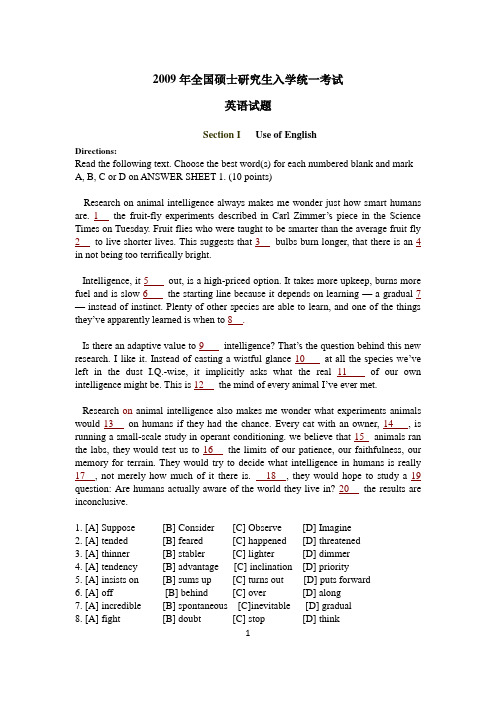
2009年全国硕士研究生入学统一考试英语试题Section I Use of EnglishDirections:Read the following text. Choose the best word(s) for each numbered blank and mark A, B, C or D on ANSWER SHEET 1. (10 points)Research on animal intelligence always makes me wonder just how smart humans are.1 the fruit-fly experiments described in Carl Zimmer‘s piece in the Science Times on Tuesday. Fruit flies who were taught to be smarter than the average fruit fly 2 to live shorter lives. This suggests that 3 bulbs burn longer, that there is an 4 in not being too terrifically bright.Intelligence, it 5 out, is a high-priced option. It takes more upkeep, burns more fuel and is slow 6 the starting line because it depends on learning — a gradual 7 — instead of instinct. Plenty of other species are able to learn, and one of the things they‘ve apparently learned is when to 8 .Is there an adaptive value to 9 intelligence? That‘s the question behind this new research. I like it. Instead of casting a wistful glance 10 at all the species we‘ve left in the dust I.Q.-wise, it implicitly asks what the real11 of our own intelligence might be. This is 12 the mind of every animal I‘ve ever met.Research on animal intelligence also makes me wonder what experiments animals would 13 on humans if they had the chance. Every cat with an owner, 14 , is running a small-scale study in operant conditioning. we believe that 15 animals ran the labs, they would test us to 16 the limits of our patience, our faithfulness, our memory for terrain. They would try to decide what intelligence in humans is really 17 , not merely how much of it there is. 18 , they would hope to study a 19 question: Are humans actually aware of the world they live in? 20 the results are inconclusive.1. [A] Suppose [B] Consider [C] Observe [D] Imagine2. [A] tended [B] feared [C] happened [D] threatened3. [A] thinner [B] stabler [C] lighter [D] dimmer4. [A] tendency [B] advantage [C] inclination [D] priority5. [A] insists on [B] sums up [C] turns out [D] puts forward6. [A] off [B] behind [C] over [D] along7. [A] incredible [B] spontaneous [C]inevitable [D] gradual8. [A] fight [B] doubt [C] stop [D] think19. [A] invisible [B] limited [C] indefinite [D] different10. [A] upward [B] forward [C] afterward [D] backward11. [A] features [B] influences [C] results [D] costs12. [A] outside [B] on [C] by [D] across13. [A] deliver [B] carry [C] perform [D] apply14. [A] by chance [B] in contrast [C] as usual [D] for instance15. [A] if [B] unless [C] as [D] lest16. [A] moderate [B] overcome [C] determine [D] reach17. [A] at [B] for [C] after [D] with18. [A] Above all [B] After all [C] However [D] Otherwise19. [A] fundamental [B] comprehensive [C] equivalent [D] hostile20. [A] By accident [B] In time [C] So far [D] Better stillSection II Reading ComprehensionPart ADirections:Read the following four texts. Answer the questions below each text by choosing A, B, C or D. Mark your answers on ANSWER SHEET 1. (40 points)Text1Habits are a funny thing. We reach for them mindlessly, setting our brains on auto-pilot and relaxing into the unconscious comfort of familiar routine. ―Not choice, but habit rules the unreflecting herd,‖ William Wordsworth said in the 19th century. In the ever-changing 21st century, even the word ―habit‖ carries a ne gative connotation.So it seems antithetical to talk about habits in the same context as creativity and innovation. But brain researchers have discovered that when we consciously develop new habits, we create parallel synaptic paths, and even entirely new brain cells, that can jump our trains of thought onto new, innovative tracks.But don‘t bother trying to kill off old habits; once those ruts of procedure are worn into the hippocampus, they‘re there to stay. Instead, the new habits we deliberately ingrain into ourselves create parallel pathways that can bypass those old roads.―The first thing needed for innovation is a fascination with wonder,‖ says Dawna Markova, author of ―The Open Mind‖ and an executive change consultant for Professional Thinking Part ners. ―But we are taught instead to ‗decide,‘ just as our president calls himself ‗the Decider.‘‖ She adds, however, that ―to decide is to kill off all possibilities but one. A good innovational thinker is always exploring the many other possibilities.‖A ll of us work through problems in ways of which we‘re unaware, she says. Researchers in the late 1960 covered that humans are born with the capacity to2approach challenges in four primary ways: analytically, procedurally, relationally (or collaboratively) and innovatively. At puberty, however, the brain shuts down half of that capacity, preserving only those modes of thought that have seemed most valuable during the first decade or so of life.The current emphasis on standardized testing highlights analysis and procedure, meaning that few of us inherently use our innovative and collaborative modes of thought. ―This breaks the major rule in the American belief system — that anyone can do anything,‖ explains M. J. Ryan, author of the 2006 book ―This Year I Will...‖ and Ms. Markova‘s business partner. ―That‘s a lie that we have perpetuated, and it fosters commonness. Knowing what you‘re good at and doing even more of it creates excellence.‖ This is where developing new habits comes in.21. The view of Wordsworth habit is claimed by beingA. casualB. familiarC. mechanicalD. changeable.22. The researchers have discovered that the formation of habit can beA. predictedB. regulatedC. tracedD. guided23.‖ ruts‖(in li ne one, paragraph 3) has closest meaning toA. tracksB. seriesC. characteristicsD. connections24. Ms. Markova‘s comments suggest that the practice of standard testing ? A, prevents new habits form being formedB, no longer emphasizes commonnessC, maintains the inherent American thinking modelD, complies with the American belief system25. Ryan most probably agree thatA. ideas are born of a relaxing mindB. innovativeness could be taughtC. decisiveness derives from fantastic ideasD. curiosity activates creative mindsText 2It is a wise father that knows his own child, but today a man can boost his paternal (fatherly) wisdom –or at least confirm that he‘s the kid‘s dad. All he needs to do is shell our $30 for paternity testing kit (PTK) at his local drugstore – and another $120 to get the results.More than 60,000 people have purchased the PTKs since they first become available without prescriptions last years, according to Doug Fog, chief operating officer of Identigene, which makes the over-the-counter kits. More than two dozen companies sell DNA tests Directly to the public , ranging in price from a few hundred dollars to more than $2500.3Among the most popular : paternity and kinship testing , which adopted children can use to find their biological relatives and latest rage a many passionate genealogists-and supports businesses that offer to search for a family‘s geographic roots .Most tests require collecting cells by webbing saliva in the mouth and sending it to the company for testing. All tests require a potential candidate with whom to compare DNA.But some observers are skeptical, ―There is a kind of false precision being hawked by people claiming they are doing ancestry testing,‖ says Trey Duster, a New York University sociologist. He notes that each individual has many ancestors-numbering in the hundreds just a few centuries back. Yet most ancestry testing only considers a single lineage, either the Y chromosome inherited through men in a father‘s line or mito chondrial DNA, which a passed down only from mothers. This DNA can reveal genetic information about only one or two ancestors, even though, for example, just three generations back people also have six other great-grandparents or, four generations back, 14 other great-great-grandparents.Critics also argue that commercial genetic testing is only as good as the reference collections to which a sample is compared. Databases used by some companies don‘t rely on data collected systematically but rather lump together information from different research projects. This means that a DNA database may differ depending on the company that processes the results. In addition, the computer programs a company uses to estimate relationships may be patented and not subject to peer review or outside evaluation.26.In paragraphs 1 and 2 , the text shows PTK‘s ___________.[A]easy availability[B]flexibility in pricing[C] successful promotion[D] popularity with households27. PTK is used to __________.[A]locate one‘s b irth place[B]promote genetic research[C] identify parent-child kinship[D] choose children for adoption28. Skeptical observers believe that ancestry testing fails to__________.[A]trace distant ancestors[B] rebuild reliable bloodlines[C] fully use genetic information[D] achieve the claimed accuracy29. In the last paragraph ,a problem commercial genetic testing faces is __________.4[A]disorganized data collection[B] overlapping database building30. An appropriate title for the text is most likely to be__________.[A]Fors and Againsts of DNA testing[B] DNA testing and It‘s problems[C]DNA testing outside the lab[D] lies behind DNA testingText 3The relationship between formal education and economic growth in poor countries is widely misunderstood by economists and politicians alike progress in both area is undoubtedly necessary for the social, political and intellectual development of these and all other societies; however, the conventional view that education should be one of the very highest priorities for promoting rapid economic development in poor countries is wrong. We are fortunate that is it, because new educational systems there and putting enough people through them to improve economic performance would require two or three generations. The findings of a research institution have consistently shown that workers in all countries can be trained on the job to achieve radical higher productivity and, as a result, radically higher standards of living.Ironically, the first evidence for this idea appeared in the United States. Not long ago, with the country entering a recessing and Japan at its pre-bubble peak. The U.S. workforce was derided as poorly educated and one of primary cause of the poor U.S. economic performance. Japan was, and remains, the global leader in automotive-assembly productivity. Yet the research revealed that the U.S. factories of Honda Nissan, and Toyota achieved about 95 percent of the productivity of their Japanese countere pants a result of the training that U.S. workers received on the job.More recently, while examing housing construction, the researchers discovered that illiterate, non-English- speaking Mexican workers in Houston, Texas, consistently met best-practice labor productivity standards despite the complexity of the building industry‘s work.What is the real relationship between education and economic development? We have to suspect that continuing economic growth promotes the development of education even when governments don‘t force it. After all, that‘s how education got started. When our ancestors were hunters and gatherers 10,000 years ago, they didn‘t have time to wonder much about anything besides finding food. Only when humanity began to get its food in a more productive way was there time for other things.As education improved, humanity‘s productivity potential, they could in turn afford more education. This increasingly high level of education is probably a necessary, but not a sufficient, condition for the complex political systems required by advanced5economic performance. Thus poor countries might not be able to escape their poverty traps without political changes that may be possible only with broader formal education. A lack of formal education, however, doesn‘t const rain the ability of the developing world‘s workforce to substantially improve productivity for the forested future. On the contrary, constraints on improving productivity explain why education isn‘t developing more quickly there than it is.31. The author holds in paragraph 1 that the important of education in poor countries ___________.[A] is subject groundless doubts[B] has fallen victim of bias[C] is conventional downgraded[D] has been overestimated32. It is stated in paragraph 1 that construction of a new education system __________.[A]challenges economists and politicians[B]takes efforts of generations[C] demands priority from the government[D] requires sufficient labor force33.A major difference between the Japanese and U.S workforces is that __________.[A] the Japanese workforce is better disciplined[B] the Japanese workforce is more productive[C]the U.S workforce has a better education[D] ]the U.S workforce is more organize34. The author quotes the example of our ancestors to show that education emerged __________.[A] when people had enough time[B] prior to better ways of finding food[C] when people on longer went hung[D] as a result of pressure on government35. According to the last paragraph , development of education __________.[A] results directly from competitive environments[B] does not depend on economic performance[C] follows improved productivity[D] cannot afford political changesText 4The most thoroughly studied in the history of the new world are the ministers and political leaders of seventeenth-century New England. According to the standard history of American philosophy, nowhere else in colonial America was ―So much6important attached to intellectual pursuits ‖ Accord ing to many books and articles, New England‘s leaders established the basic themes and preoccupations of an unfolding, dominant Puritan tradition in American intellectual life.To take this approach to the New Englanders normally mean to start with the Puritans‘ theological innovations and their distinctive ideas about the church-important subjects that we may not neglect. But in keeping with our examination of southern intellectual life, we may consider the original Puritans as carriers of European culture adjusting to New world circumstances. The New England colonies were the scenes of important episodes in the pursuit of widely understood ideals of civility and virtuosity.The early settlers of Massachusetts Bay included men of impressive education and influence in England. `Besides the ninety or so learned ministers who came to Massachusetts church in the decade after 1629,There were political leaders like John Winthrop, an educated gentleman, lawyer, and official of the Crown before he journeyed to Boston. There men wrote and published extensively, reaching both New World and Old World audiences, and giving New England an atmosphere of intellectual earnestness.We should not forget , however, that most New Englanders were less well educated. While few crafts men or farmers, let alone dependents and servants, left literary compositions to be analyzed, The in thinking often had a traditional superstitions quality. A tailor named John Dane, who emigrated in the late 1630s, left an account of his reasons for leaving England that is filled with signs. sexual confusion, economic frustrations , and religious hope-all name together in a decisive moment when he opened the Bible, told his father the first line he saw would settle his fate, and read th e magical words: ―come out from among them, touch no unclean thing , and I will be your God and you shall be my people.‖ One wonders what Dane thought of the careful sermons explaining the Bible that he heard in puritan churched.Mean while , many se ttles had slighter religious commitments than Dane‘s, as one clergyman learned in confronting folk along the coast who mocked that they had not come to the New world for religion . ―Our main end was to catch fish. ‖36. The author notes that in the seventeenth-century New England___________.[A] Puritan tradition dominated political life.[B] intellectual interests were encouraged.[C] Politics benefited much from intellectual endeavors.[D] intellectual pursuits enjoyed a liberal environment.37. It is suggested in paragraph 2 that New Englanders__________.[A] experienced a comparatively peaceful early history.[B] brought with them the culture of the Old World[C] paid little attention to southern intellectual life[D] were obsessed with religious innovations738. The early ministers and political leaders in Massachusetts Bay__________.[A] were famous in the New World for their writings[B] gained increasing importance in religious affairs[C] abandoned high positions before coming to the New World[D] created a new intellectual atmosphere in New England39. The story of John Dane shows that less well-educated New Englanders were often __________.[A] influenced by superstitions[B] troubled with religious beliefs[C] puzzled by church sermons[D] frustrated with family earnings40. The text suggests that early settlers in New England__________.[A] were mostly engaged in political activities[B] were motivated by an illusory prospect[C] came from different backgrounds.[D] left few formal records for later referencePart BDirections:Directions: In the following text, some sentences have been removed. For Questions (41-45), choose the most suitable one from the list A-G to fit into each of the numbered blank. There are two extra choices, which do not fit in any of the gaps. Mark your answers on ANSWER SHEET 1. (10 points)Coinciding with the groundbreaking theory of biological evolution proposed by British naturalist Charles Darwin in the 1860s, British social philosopher Herbert Spencer put forward his own theory of biological and cultural evolution. Spencer argued that all worldly phenomena, including human societies, changed over time, advancing toward perfection. 41.____________.American social scientist Lewis Henry Morgan introduced another theory of cultural evolution in the late 1800s. Morgan, along with Tylor, was one of the founders of modern anthropology. In his work, he attempted to show how all aspects of culture changed together in the evolution of societies.42._____________.In the early 1900s in North America, German-born American anthropologist Franz Boas developed a new theory of culture known as historical particularism. Historical particularism, which emphasized the uniqueness of all cultures, gave new direction to anthropology. 43._____________ .8Boas felt that the culture of any society must be understood as the result of a unique history and not as one of many cultures belonging to a broader evolutionary stage or type of culture. 44._______________.Historical particularism became a dominant approach to the study of culture in American anthropology, largely through the influence of many students of Boas. But a number of anthropologists in the early 1900s also rejected the particularist theory of culture in favor of diffusionism. Some attributed virtually every important cultural achievement to the inventions of a few, especially gifted peoples that, according to diffusionists, then spread to other cultures. 45.________________.Also in the early 1900s, French sociologist Émile Durkheim developed a theory of culture that would greatly influence anthropology. Durkheim proposed that religious beliefs functioned to reinforce social solidarity. An interest in the relationship between the function of society and culture—known as functionalism—became a major theme in European, and especially British, anthropology.[A] Other anthropologists believed that cultural innovations, such as inventions, had a single origin and passed from society to society. This theory was known as diffusionism.[B] In order to study particular cultures as completely as possible, Boas became skilled in linguistics, the study of languages, and in physical anthropology, the study of human biology and anatomy.[C] He argued that human evolution was characterized by a struggle he called the ―survival of the fittest,‖ in which weaker races and societies must eventu ally be replaced by stronger, more advanced races and societies.[D] They also focused on important rituals that appeared to preserve a people‘s social structure, such as initiation ceremonies that formally signify children‘s entrance into adulthood.[E] Thus, in his view, diverse aspects of culture, such as the structure of families, forms of marriage, categories of kinship, ownership of property, forms of government, technology, and systems of food production, all changed as societies evolved.[F]Supporters of the theory viewed as a collection of integrated parts that work together to keep a society functioning.[G] For example, British anthropologists Grafton Elliot Smith and W. J. Perry incorrectly suggested, on the basis of inadequate information, that farming, pottery9making, and metallurgy all originated in ancient Egypt and diffused throughout the world. In fact, all of these cultural developments occurred separately at different times in many parts of the world.Part CDirections:Read the following text carefully and then translate the underlined segments into Chinese. Your translation should be written carefully on ANSWER SHEET 2. (10 points)There is a marked difference between the education which every one gets from living with others, and the deliberate educating of the young. In the former case the education is incidental; it is natural and important, but it is not the express reason of the association.46It may be said that the measure of the worth of any social institution is its effect in enlarging and improving experience; but this effect is not a part of its original motive. Religious associations began, for example, in the desire to secure the favor of overruling powers and to ward off evil influences; family life in the desire to gratify appetites and secure family perpetuity; systematic labor, for the most part, because of enslavement to others, etc. 47Only gradually was the by-product of the institution noted, and only more gradually still was this effect considered as a directive factor in the conduct of the institution. Even today, in our industrial life, apart from certain values of industriousness and thrift, the intellectual and emotional reaction of the forms of human association under which the world's work is carried on receives little attention as compared with physical output.But in dealing with the young, the fact of association itself as an immediate human fact, gains in importance.48 While it is easy to ignore in our contact with them the effect of our acts upon their disposition, it is not so easy as in dealing with adults. The need of training is too evident; the pressure to accomplish a change in their attitude and habits is too urgent to leave these consequences wholly out of account. 49Since our chief business with them is to enable them to share in a common life we cannot help considering whether or no we are forming the powers which will secure this ability.If humanity has made some headway in realizing that the ultimate value of every institution is its distinctively human effect we may well believe that this lesson has been learned largely through dealings with the young.50 We are thus led to distinguish, within the broad educational process which we have been so far considering, a more formal kind of education -- that of direct tuition or schooling. In undeveloped social groups, we find very little formal teaching and training. These groups mainly rely for instilling needed dispositions into the young upon the same sort of association which keeps the adults loyal to their group.Section & Writing10Part A51. Directions:Restrictions on the use of plastic bags have not been so successful in some regions. ―White pollution ‖is still going on. Write a letter to the editor(s) of your local newspaper to1)give your opinions briefly and2)make two or three suggestionsYou should write about 100 words. Do not sign your own name at the end of the letter. Use "Li Ming" instead. You do not need to write the address.Part B52. Directions:In your essay, you should1) describe the drawing briefly,2) explain its intended meaning, and then3) give your comments.You should write neatly on ANSHWER SHEET 2. (20 points)11。
浙江师范大学语言学概论2009真题

科目代码:833 提示: 1、 本科目适用专业:语言学及应用语言学、汉语言文字学、中国古典文献学; 2、 请将所有答案写于答题纸上,写在试题上的不给分; 3、 请填写准考证号后 6 位:____________。 一、填空题(20 空;每空 2 分,共 40 分) 1、现代语言学的奠基者是( 2、语言是( ( 叫( ( ) 。 6、语言单位在相同的语言环境下出现能够区别意义,叫( 7、语言的( 不会影响理解。 8、文字是( ( ) 。 10、皮钦语被当作母语来使用,就成了( ) 。 ) 。 11、研究语言或者方言在不同地区的差异和分布的学科,叫( 反映乙类事物,这种现象叫( 13、语句字面上的意义,叫( ) 。 ) ,是对客观事物的表述。 )三个明显特点。 )两个系统的结合,具有音、形、义三个要素。 9、从一种语言分化出来的若干种独立的语言,彼此有同源关系,它们叫 ) 。 )机制使得人们在交际时,即使遇到外界的某些干扰,也 )的载体。 ) 。 科目名称:语言学概论
第 2 页 共 2 页
) 。
2、聚合关系 5、歧义
3、超音质音位 6、语言联盟
四、国际音标注音(每词 2 分,共 10 分。声调用调值标注法标注,变调也要标
第 3 页
共 2 页
第 1 页 共 2 页
15、如果一个语言片段可以由比它长的语言片段替代,那么后者就是前者的 )的产物,共同语的形成是语言走向
17、语言的发展Βιβλιοθήκη 有渐变性和( 18、中国的语言分属于汉藏语系、 ( 欧语系等 5 个语系。
)两个特点。 )语系、南亚语系、南岛语系和印
19、一种语言排挤和替代其他语言而成为不同民族的共用的交际工具,其他 语言则因不再使用而逐渐消亡,这种现象叫( 二、判断题(10 小题;每题 1 分,共 10 分) 1、语言既具有社会性又具有个人性;因此,可以说“鲁迅杂文的语言是犀利 的” 。 2、语言符号本质上是任意的,但也具有一定程度的理据性,因此,词语相对 于构成它的语素来说具有可理解性。 3、在英语单词“worker” (工人)中, “er”是构形后缀。 4、音位与音素是抽象的语音类型与具体的发音之间的关系。 5、按表达语法意义的语法手段来分类,汉语属于汉藏语系。 6、构成隐性语法关系的成分可以是非连续的。例如在“大家圆圆地坐成了一 个圈儿”中“圆圆地”指向“圈儿” 。 7、现代汉语书面语中,第三人称表示男性用“他” ,表示女性用“她” ,这说 明现代汉语代词系统中有性这个语法范畴。 8、英语属于印欧语系的日耳曼语族。 9、语言是第一性的,文字是第二性的,语言是文字的基础,但文字也可以与 语言脱节。 10、在“我没给他写信”中, “没”否定的是过去,这说明否定词具有兼表时 制的作用,这是语言的预设机制在起作用。 三、名词解释(6 小题;每小题 5 分,共 30 分。必须举例) 1、符号 4、义素分析 出) 忽然 休假 英语 一半儿 尾巴 五、论述题(60 分) 1、为什么人类的语言构造具有灵巧性?(20 分) 2、以实例论述语言交际的合作原则。 (20 分) 3、怎样理解语言的社会变异?(20 分)
北二外语言学09真题

北二外语言学09真题北京第二外国语学院2009年硕士研究生入学考试试卷I Complete each of the following statements. (5 points/1 point each)1. Human languages enable their users to symbolize objects, events and concepts which are notpresent (in time and space) at the moment of communication. This quality is labeled as_.2. The sound [p] can be described with " _________________ , bilabial, stop".3. The different members of a phoneme, sounds which are phonetically different but do not makeone word different from another in meaning, are_.4. Both semantics and _____________ investigate linguistic meaning, but they focus on differentaspects.5. If certain linguistics tries to lay down rules for the correct use of language and settle the disputes over usage once and for all, it is_linguists.II Determine if each of the following statements is true or false. (5 points/1 point each)1. The speech sounds which are in complementary distribution are not always allophones of the same phoneme.2. The last sound of "sit" can be articulated as an unreleased or released plosive. These differentrealizations of the same phoneme are not in complementary distribution.3. The sound [z]is shared by "boys" and "moves" as acommon morpheme.4. Speech act theory was proposed by Grice.5. Phonology is language specific but phonetics is not.ⅢFulfill the following requirements. (15 points)1. Analyze the sentence "The boy chased the dog." by means of IC. (2)2. Tell whether each of the underlined parts is endocentric or exocentric. (2)a. He left because he was tired,b. the issue in question3. Give the phonetic term according to the following description: (1 )the sound made with tongue tip and the back of the alveolar ridge.4. Analyze the following dialogue with reference to CP: (2)A: I know you are a famous musician. Could you define music, please?B: Well, music is music. That′s it.5.Tell the sense relation between a and b in each pair: (2)l) a. John's car is secondhand. b. John has a car.2) a. Mary helped Jane. b. Jane was helped by Mary.6. Classify the following pairs of antonyms. (2)even --- odd above---belowpresent --- absent arrogant --- humble7.Point out the commonness shared by the two sounds[d]and[n]. (2)8.Explain the notion of "root" used in morphology.(2)IV Answer each of the following questions briefly. (25 points/ 5 points each)1. How do you understand the distinction between langueand parole introduced by Saussure?2. How are the vowels described usually?3. How do you understand performative function of language?4. What is syntax?5. How do you understand arbitrariness?。
南开大学2009年语言学概论考研真题
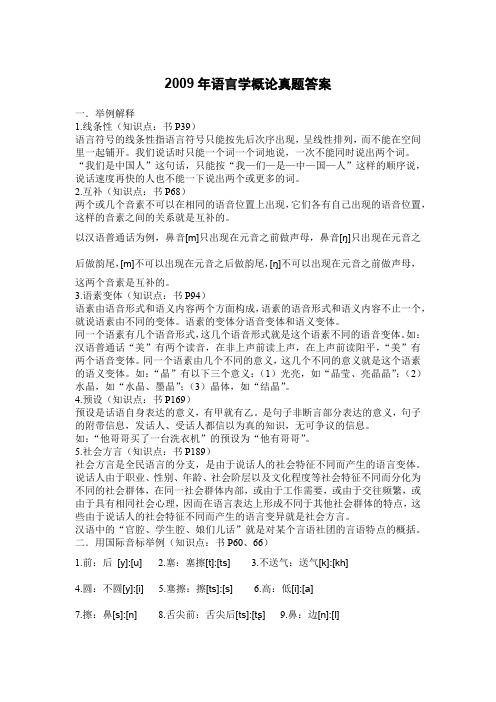
2009年语言学概论真题答案一.举例解释1.线条性(知识点:书P39)语言符号的线条性指语言符号只能按先后次序出现,呈线性排列,而不能在空间里一起铺开。
我们说话时只能一个词一个词地说,一次不能同时说出两个词。
“我们是中国人”这句话,只能按“我—们—是—中—国—人”这样的顺序说,说话速度再快的人也不能一下说出两个或更多的词。
2.互补(知识点:书P68)两个或几个音素不可以在相同的语音位置上出现,它们各有自己出现的语音位置,这样的音素之间的关系就是互补的。
以汉语普通话为例,鼻音[m]只出现在元音之前做声母,鼻音[ŋ]只出现在元音之后做韵尾,[m]不可以出现在元音之后做韵尾,[ŋ]不可以出现在元音之前做声母,这两个音素是互补的。
3.语素变体(知识点:书P94)语素由语音形式和语义内容两个方面构成,语素的语音形式和语义内容不止一个,就说语素由不同的变体。
语素的变体分语音变体和语义变体。
同一个语素有几个语音形式,这几个语音形式就是这个语素不同的语音变体。
如:汉语普通话“美”有两个读音,在非上声前读上声,在上声前读阳平,“美”有两个语音变体。
同一个语素由几个不同的意义,这几个不同的意义就是这个语素的语义变体。
如:“晶”有以下三个意义:(1)光亮,如“晶莹、亮晶晶”;(2)水晶,如“水晶、墨晶”;(3)晶体,如“结晶”。
4.预设(知识点:书P169)预设是话语自身表达的意义,有甲就有乙。
是句子非断言部分表达的意义,句子的附带信息,发话人、受话人都信以为真的知识,无可争议的信息。
如:“他哥哥买了一台洗衣机”的预设为“他有哥哥”。
5.社会方言(知识点:书P189)社会方言是全民语言的分支,是由于说话人的社会特征不同而产生的语言变体。
说话人由于职业、性别、年龄、社会阶层以及文化程度等社会特征不同而分化为不同的社会群体,在同一社会群体内部,或由于工作需要,或由于交往频繁,或由于具有相同社会心理,因而在语言表达上形成不同于其他社会群体的特点,这些由于说话人的社会特征不同而产生的语言变异就是社会方言。
09年年语概真题解析
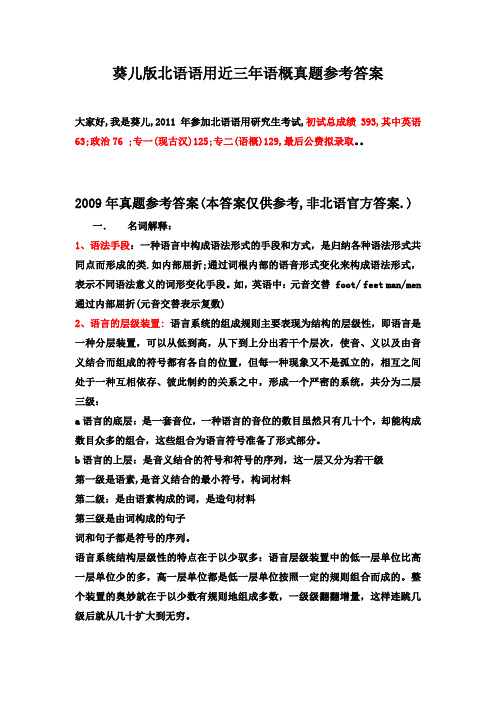
葵儿版北语语用近三年语概真题参考答案大家好,我是葵儿,2011年参加北语语用研究生考试,初试总成绩393,其中英语63;政治76 ;专一(现古汉)125;专二(语概)129,最后公费拟录取。
2009年真题参考答案(本答案仅供参考,非北语官方答案.) 一.名词解释:1、语法手段:一种语言中构成语法形式的手段和方式,是归纳各种语法形式共同点而形成的类.如内部屈折;通过词根内部的语音形式变化来构成语法形式,表示不同语法意义的词形变化手段。
如,英语中:元音交替 foot/ feet man/men 通过内部屈折(元音交替表示复数)2、语言的层级装置:语言系统的组成规则主要表现为结构的层级性,即语言是一种分层装置,可以从低到高,从下到上分出若干个层次,使音、义以及由音义结合而组成的符号都有各自的位置,但每一种现象又不是孤立的,相互之间处于一种互相依存、彼此制约的关系之中,形成一个严密的系统,共分为二层三级:a语言的底层:是一套音位,一种语言的音位的数目虽然只有几十个,却能构成数目众多的组合,这些组合为语言符号准备了形式部分。
b语言的上层:是音义结合的符号和符号的序列,这一层又分为若干级第一级是语素,是音义结合的最小符号,构词材料第二级:是由语素构成的词,是造句材料第三级是由词构成的句子词和句子都是符号的序列。
语言系统结构层级性的特点在于以少驭多:语言层级装置中的低一层单位比高一层单位少的多,高一层单位都是低一层单位按照一定的规则组合而成的。
整个装置的奥妙就在于以少数有规则地组成多数,一级级翻翻增量,这样连跳几级后就从几十扩大到无穷。
3、会话含义:在言语交际中,人们由于种种原因不严格的遵守言语交际的合作原则及其相关准则和次准则,当说话人违反了这些准则或次准则时,听话人就迫使自己超越话语的表面意义去设法领悟说话人所说话语的隐含意义,这种汉语的隐含意义,即会话含义。
如,甲问:“我们今晚一起去看电影好吗?”乙答:“我明天要考英语。
2009年10月自考《语言学概论》00541真题及答案

2009年10月自考《语言学概论》真题及答案课程代码00541单项选择题本大题共20小题,每小题1分,共20分。
在每小题列出的四个备选项中只有一项是最符合题目要求的,请将其选出。
1、提出“民族的语言即民族的精神,民族的精神即民族的语言”这一著名论断的语言学家是()A.洪堡特B.索绪尔C.乔姆斯基D.布龙菲尔德正确答案:A2、语言系统的各个子系统中,系统性最强的是()A.语音系统B.语汇系统C.语法系统D.语义系统正确答案:A3、下列辅音,在普通话中既能充当声母、又能充当韵尾的是()A.[p]B.[t]C.[m]D.[n]正确答案:D4、普通话“江”字读音所含音素的数量是()A.2个B.3个C.4个D.5个正确答案:C5、下列各组中,加括号成分属于同一语素的一组是()A.(虎)口、马(虎)B.(白)菜、(白)费C.(花)费、菊(花)D.(土)改、黄(土)正确答案:D6、“不入虎穴,焉得虎子”属于()A.谚语B.成语C.歇后语D.惯用语正确答案:B7、下列词语中,不能看作离合词的是()A.登陆B.散步C.洗澡D.睡觉正确答案:A8、“词法”也称()B.构词法C.造词法D.造句法正确答案:A9、汉语中不能表示“定指”的语法手段是()A.谓语动词前的光杆名词B.前面加上指示代词的名词C.介词“把、被”后的名词D.前面加上数量词的名词正确答案:D10、英语“Mary writed a letter”中动词的词形变化有错误,正确形式应该采用()A.附加形式B.屈折形式C.异根形式D.零形式正确答案:B11、“团结”和“勾结”在词义上最主要的差别在于()A.理性意义不同B.感情色彩不同C.形象色彩不同D.语体色彩不同正确答案:B12、多义词的多个意义中,最常用最主要的意义叫做()B.基本义C.派生义D.引申义正确答案:B13、下列关于反义词的表述,正确的一项是()A.理性意义上的细微差异可以构成反义词B.附加色彩上的褒贬对立可以构成反义词C.一个词可以和几个不同的词互为反义词D.不同语言的词之间可以构成反义词正确答案:C14、语言谱系分类的层级体系中,最小的类别是()A.语系B.语支C.语群D.语族正确答案:C15、下列关于亲属语言的表述,不正确的一项是()A.亲属语言是社会完全分化的产物B.亲属语言是一种语言的地域变体C.亲属语言具有历史同源关系D.语音对应关系是亲属语言的重要标志正确答案:B16、用本族语言的语素逐个对译外语原词的语素而产生的词是()A.音译词C.意译词D.半音译半意译词正确答案:B17、发散思维(外思维)活动不包括()A.记忆B.情感C.意志D.美感正确答案:A18、下列关于“大脑皮质”的表述,不正确的是()A.是由成百亿神经元和神经纤维构成的B.从各个器官接收信息并引发人的行为C.用于控制人体的运动平衡和内脏功能D.是行为动作决策机构和记忆存储仓库正确答案:C19、下列各项中,不属于外语教学特点的是()A.基础性B.交叉性C.多元性D.典型性正确答案:D20、下列信息处理研究中,尚未取得突破性进展的项目是()A.汉字编码和输入B.语料标注和检索C.文本自动校对D.机器自动翻译正确答案:D多项选择题(本大题共5小题,每小题2分,共10分)在每小题列出的五个备选项中至少有两个是符合题目要求的,请将其代码填写在题后的括号内。
- 1、下载文档前请自行甄别文档内容的完整性,平台不提供额外的编辑、内容补充、找答案等附加服务。
- 2、"仅部分预览"的文档,不可在线预览部分如存在完整性等问题,可反馈申请退款(可完整预览的文档不适用该条件!)。
- 3、如文档侵犯您的权益,请联系客服反馈,我们会尽快为您处理(人工客服工作时间:9:00-18:30)。
2009年硕士研究生入学考试初试
广西民族大学自命题科目试题
(试卷代号:A卷)
科目代码:817
科目名称:语言学概论
适用学科专业:语言学及应用语言学、汉语言文字学
中国少数民族语言文学
研究方向:
命题教师签名:
考生须知
1.答案必须写在答题纸上,写在试题册上无效。
2.答题时一律使用蓝、黑色墨水笔作答,用其它笔答题不给分。
3.交卷时,请配合监考人员验收,并请监考人员在准考证相应位置签字(作为考生
交卷的凭证)。
否则,产生的一切后果由考生自负。
一、解释下列术语(每小题5分,共6小题,共30分)
1. 人称
2. 表意字
3. 递归性
4. 任意性
5. 历史比较法
6. 词义的概括性
二、按照普通话的读音,给下列词注上国际音标(每个词2分,共10个词,共20分)
历史区域社会治安知识
英雄绿化唐朝机器人民
三、分析题(共30分)
(一)分析下列音变现象,指出其类型,并说明原因(每小题5分,共2小题,
共10分)
1. 拉丁语中的marmor(大理石),到了英语里变成了marble。
(顺异化)
2. 汉语的句子“你要回来啊!”中的“啊”念“呀”,“你看啊!”中的“啊”念“哪”。
(增音)
(二)下面的词各有几个语素?请在每个语素下面标上横线(每个词2分,共4个词,共8分)
汉语: 桌子 (两个,词根语素和定位语素) 啤酒(一个语素)
英语: workers(两个,worker和s) brother(一个)
(三)分析下列句子各用什么语法手段表达了动词的什么语法范畴(每小题3分,共4小题,共12分)
1.他来过这里。
(辅助词:着了过,表示时和体)
2.I shall go with you tomorrow.(辅助词:shall,时范畴)
3.He lent me a book yesterday.(内部屈折,时体)
4.He often speaks Chinese.(词缀,人称)
四、问答题(每小题15分,共3题,共45分)
1.文字的改进和改革有什么不同?(15分)
2.什么是音位?怎样理解音位的定义?(15分)
3.词义派生的基础是什么?什么是隐喻和换喻?(15分)
五、论述题(共25分)
以词和音位为例,说明什么是组合关系和聚合关系。
